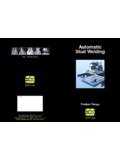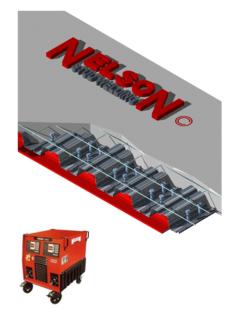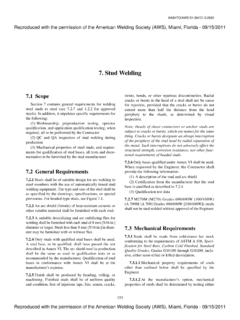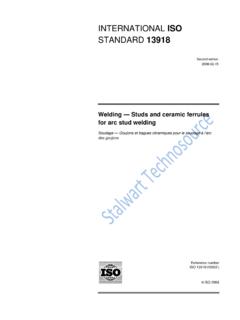Transcription of Stud Welding Practices & Procedure - PFSNO
1 Page | 1 ANSI/ AWS 93 An American National Standard Recommended Practices For Stud Welding Prepared by AWS Committee on Arc Welding and Cutting Under Direction of AWS Technical Activities Committee Approved by AWS Board of Directors Abstract These recommended Practices for stud Welding , prepared by the Subcommittee on Stud Welding of the AWS Committee on Arc Welding and Cutting, are intended to serve as a basic guide for those interested in attaching fasteners by arc and capacitor discharge stud Welding .
2 The variations of the process, stud design, equipment, Welding procedures, quality control, and safety precautions are discussed. The information presented will guide the designer and the shop in the utilization of studs in many fields including automotive manufacture, boiler and building construction, farm and industrial equipment, railroads and shipbuilding, aircraft and aerospace, metal furniture, and other metal working industries. Serving the Offshore, Industrial and Shipbuilding Industries since 1987 PH: 800- 216- 1827 Fax: 504- 891- 6229 Email: Website: Page | 2 Table 1 Stud Welding Method Selection Chart Capacitor Discharge Stud Welding Factors to be considered Arc Stud Welding Gap and Contact Drawn- Arc Stud Shape A A A Round A A A Square A A A Rectangular A A A Irregular A A A Stud diameter or area 1/16 to 1/8 in.
3 ( to mm) D A A 1/8 to 1/4 in. ( to mm) C A A 1/4 to 1/2 in. ( to ) A B B 1/2 to 1 in. ( to ) A D D Up to in. ( mm ) C A A Over in. ( mm ) A D D Stud Metal Carbon Steel A A A Stainless Steel A A A Alloy Steel B C C Aluminum B A A Brass C A D Base Metal Carbon Steel A A A Stainless Steel A A A Alloy Steel B A C Aluminum B A A Brass C A D Base Metal Thickness Under in. ( mm) to in. D A B ( mm to mm) to in. C A A ( mm to mm) B A A Over in. ( mm) A A A Strength Criteria Heat effect on exposed surfaces B A A Weld fillet clearance B A A Strength of stud governs A A A Strength of base metal governs A A A Base Metal Thickness For base thickness under in.
4 ( mm), the capacitor discharge stud Welding methods should be used. Using these methods, the base metal can be as thin as in. ( mm) without melt- through occurring. On such thin material, the sheet will tear when the stud is loaded excessively. Reverse side marking is the principal effect involved in appearance. Using the arc stud Welding process, the base metal thickness should be at least one- third the weld base diameter of the stud to assure maximum stud strength. Legend: A- Applicable without special procedures or equipment B- Applicable with special techniques or for specific applications that justify preliminary trials or testing to develop Welding Procedure and technique. C- Limited application D- Not recommended.
5 Welding methods not developed at this time. Serving the Offshore, Industrial and Shipbuilding Industries since 1987 PH: 800- 216- 1827 Fax: 504- 891- 6229 Email: Website: Page | 3 Designing for Stud Welding Base Metal Low Carbon Steel Low Carbon (mild) steels can be stud welded with no major metallurgical problems. The upper carbon limit for steel to be arc stud welded without preheat is percent. Medium and High Carbon Steel If medium and high- carbon steel are to be stud welded, it is imperative that preheat be used to prevent cracking in the heat- affected zones. In some instances, a combination of preheating and post heating after Welding is recommended.
6 In the case of tough alloy steels, either preheating or post heating may be used to obtain satisfactory results. Low Alloy Steel Generally, the high strength, low alloy steels are satisfactory stud welded when their carbon content is percent or lower. If carbon content exceeds percent, it may be necessary to preheat the work to a low preheat temperature to obtain desired toughness in the weld area. When the hardness of the heat- affected zones and the stud fillet does not exceed 30 Rockwell C, studs can be expected to perform well under almost any type of severe service. Although good results have been obtained with hardness ranges up to 35 Rockwell C, it is best to avoid extremely high working stresses and fatigue loading.
7 In special cases where microstructures are important, the weld should be evaluated and qualified for specific application considered. Since alloy steels vary in toughness and ductility at high hardness levels, weld hardness should not be used as the sole criterion for weld evaluation. Table 2 Typical Combinations of Base and Stud Metals for Stud Welding Base Metal Stud Metal Arc Stud Welding Low- carbon steel, AISI 1006 to 1022ь Low- carbon steel, AISI 1006 to 1020; stainless steel, 300 series Stainless steel, 300 series, 405, 410, and 430 Low- carbon steel, AISI 1006 to 1020; stainless steel, 300 series Aluminum alloys, 5000 seriesс Aluminum alloys, 5000 seriesс Capacitor Discharge Stud Welding Low- carbon steel, AISI 1006 to 1022 Low- carbon steel, AISI 1006 to 1020; stainless steel, 300 series; copper alloy 260 and 268 Stainless steel, 300 series and 400 Low- carbon steel, AISI 1006 to 1020.
8 Stainless steel, 300 series Aluminum alloys, 1100, 3000, 5000 seriesс, 6061 and 6063 Aluminum alloys, 1100 and 5000 series and 6061 ETP copper, lead- free brass, and rolled copper Low- carbon steel, AISI 1006 to 1022; stainless steel, 300 series; copper alloys C 26000, C26800, and 464 Zinc alloys (die cast) Aluminum alloys 1100 and 5000 series Serving the Offshore, Industrial and Shipbuilding Industries since 1987 PH: 800- 216- 1827 Fax: 504- 891- 6229 Email: Website: Page | 4 Heat- Treated Structural Steel Many Structural steels used in shipbuilding and in other construction are heat- treated at the mill. Heat- treated steels require that attention be given to the metallurgical characteristics of the heat affected zone.
9 Some of these steels are sufficiently hardenable that the heat- affected zones will be martensitic. This structure will be quite sensitive to underbead cracking, and it will have insufficient ductility to carry impact loads. Therefore, for maximum toughness in these steels, a preheat of 700 F (370 C) is recommended. Consideration of the application and end use of the stud will further influence the Welding procedures to be followed. Stainless Steels Most classes of stainless steel may be stud welded. The exceptions are the free- machining grades. However, only the austenitic stainless steels (300 grades) are recommended for general application. The weldable stainless steel grades include American Iron and Steel Institute (AISI) Types 304, 305, 308, 309, 310, 316, 321, and 347.
10 Types 304, 305, and 316 are most commonly used for stud Welding . Stainless steel studs may be welded to stainless steel or mild steel as the application may require. The Welding setup used is the same as that recommended for low carbon steel except for an increase of approximately 10 percent in power requirement. Where stainless steel studs are to be welded to mild steel studs are to be welded to mild steel, it is essential that the carbon content of the base metal not exceed percent. Ferrules An individual ferrule (arc shield) is required with each stud for most applications. It is placed over the stud at the weld base where it is held in position by a grip or holder on the stud Welding gun. The ferrule performs several important functions during Welding : (1) Concentrates the heat of the arc in the weld area.






